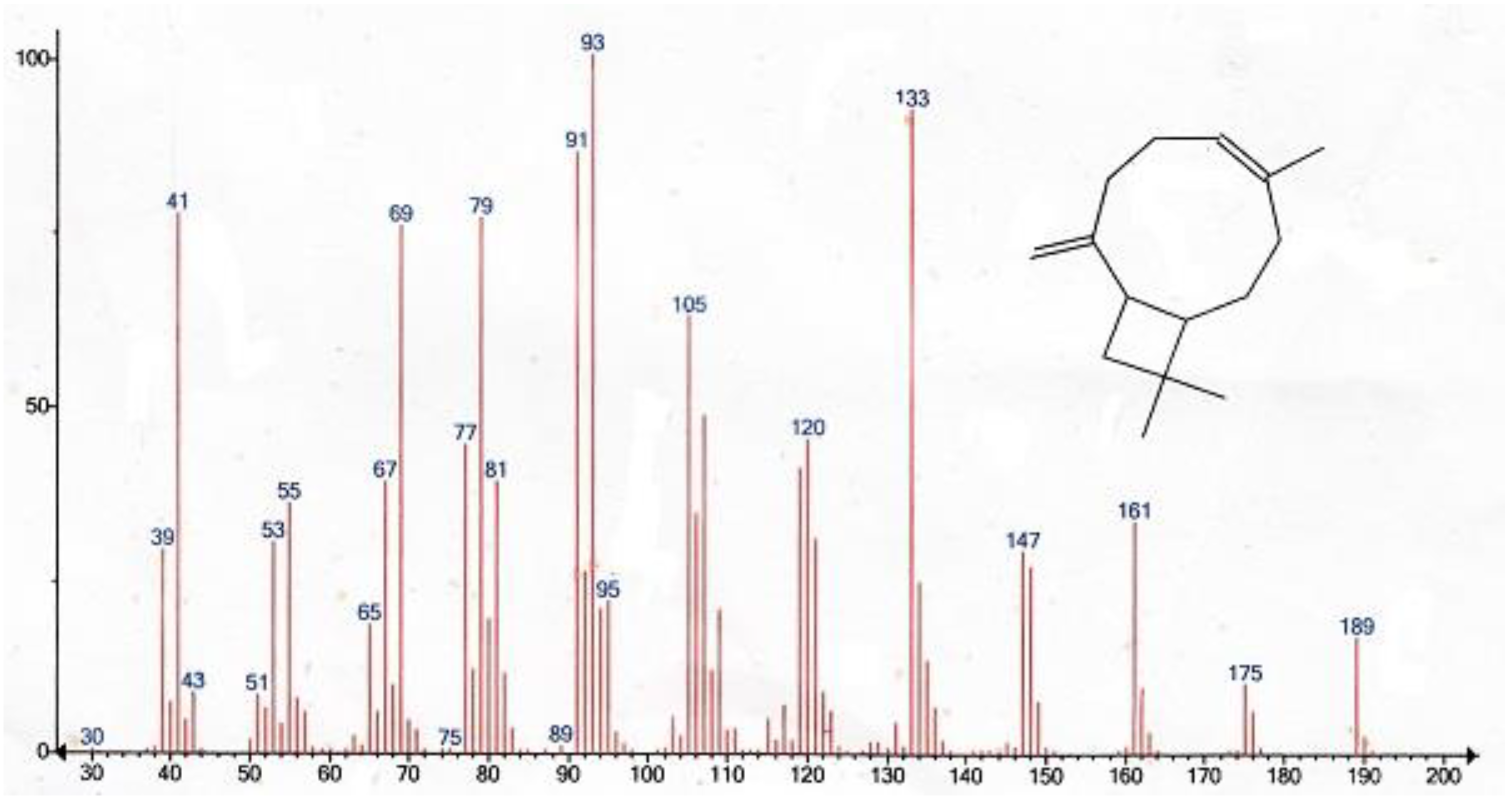β-Caryophyllene: A Single Volatile Component of n-Hexane Extract of Dracaena cinnabari Resin
Abstract
1. Introduction
2. Results and Discussion
3. Conclusions
4. Materials and Methods
4.1. Plant Material
4.2. Extraction
4.3. GC-MS Analysis
Funding
Acknowledgments
Conflicts of Interest
References
- Al-Fatimi, M. Ethnobotanical Survey of Dracaena cinnabari and investigation of the pharmacognostical properties, antifungal and antioxidant activity of its resin. Plants (Basel) 2018, 7, 91. [Google Scholar] [CrossRef] [PubMed]
- Vaníčková, L.; Pompeiano, A.; Maděra, P.; Massad, T.J.; Vahalík, P. Terpenoid profiles of resin in the genus Dracaena are species specific. Phytochemistry 2020, 170, 112197. [Google Scholar] [CrossRef]
- Sabulal, B.; Dan, M.; Kurup, A.J.J.R.; Pradeep, N.S.; Valsamma, R.K.; George, V. Caryophyllene-rich rhizome oil of Zingiber nimmonii from South India: Chemical characterization and antimicrobial activity. Phytochemistry 2006, 67, 2469–2473. [Google Scholar] [CrossRef] [PubMed]
- Sain, S.; Naoghare, P.K.; Devi, S.S.; Daiwile, A.; Krishnamurthi, K.; Arrigo, P.; Chakrabarti, T. Beta caryophyllene and caryophyllene oxide, isolated from Aegle marmelos, as the potent anti-inflammatory agents against lymphoma and neuroblastoma cells. Antiinflamm Antiallergy Agents Med. Chem. 2014, 13, 45–55. [Google Scholar] [CrossRef]
- Kubo, I.; Chaudhuri, S.K.; Kubo, Y.; Sanchez, Y.; Ogura, T.; Saito, T.; Ishikawa, H.; Haraguchi, H. Cytotoxic and antioxidative sesquiterpenoids from Heterotheca inuloides. Planta Med. 1996, 62, 427–430. [Google Scholar] [CrossRef] [PubMed]
- Al-Fatimi, M.; Friedrich, U.; Jenett-Siems, K. Cytotoxicity of plants used for traditional medicine in Yemen. Fitoterapia 2005, 76, 355–358. [Google Scholar] [CrossRef] [PubMed]
- Adams, R.P. Identification of Essential Oil Components by Gas. Chromatography/mass Spectrometry, 4th ed.; Allured Publishing Co.: Carol Stream, IL, USA, 2007. [Google Scholar]
- Teng, Z.; Zhang, M.; Meng, S.; Dai, R.; Meng, W.; Deng, Y.; Huang, L. A comparative study on volatile metabolites profile of Dracaena cochinchinensis (Lour.) SC Chen xylem with and without resin using GC-MS. Biomed. Chromatogr. 2015, 29, 1744–1749. [Google Scholar] [CrossRef] [PubMed]
- Santos, R.P.; Mendes, L.S.; Silva, B.M.; de Pinho, P.G.; Valentao, P.; Andrade, P.B.; Pereira, J.A.; Carvalho, M. Phytochemical profiles and inhibitory effect on free radical-induced human erythrocyte damage of Dracaena draco leaf: A potential novel antioxidant agent. Food Chem. 2011, 124, 927–934. [Google Scholar] [CrossRef]
- Silva, B.M.; Santos, R.P.; Mendes, L.S.; de Pinho, P.G.; Valentão, P.; Andrade, P.B.; Pereira, J.A.; Carvalho, M. Dracaena draco L. fruit: Phytochemical and antioxidant activity assessment. Food Res. Int. 2011, 44, 2182–2189. [Google Scholar] [CrossRef]
- Gurib-Fakim, A.; Demarne, F. Volatile constituents of Dracaena reflexa Lam. var. angustifolia Baker. J. Essent. Oil Res. 1994, 6, 651–652. [Google Scholar] [CrossRef]


| Retention Time (min) | Compound | Content% | Retention Index RI | Retention Index Reference RI-ref |
|---|---|---|---|---|
| 20.403 | β-Caryophyllene | 100 | 1416 | 1417 |
| Dracaena Species | Plant Part/Exudates | Method | Identification of β-Caryophyllene | Reference |
|---|---|---|---|---|
| Dracaena cinnabari | resin | HS-SPME/GC | none | [2] |
| D. serrulata | ||||
| D. ombet | ||||
| D. draco subsp. draco | ||||
| D. draco subsp. ajgal | ||||
| D. cochinchinensis | resin | n-Hexane extraction | none | [8] |
| D. draco | fruit | HS-SPME/GC | β-caryophyllene | [9] |
| D. draco | leaf | HS-SPME/GC | β-caryophyllene | [10] |
| D. reflexa var. angustqo | leaf | steam distillate was extracted into hexane | β-caryophyllene | [11] |
Sample Availability: Samples of the compound are not available. | |
Publisher’s Note: MDPI stays neutral with regard to jurisdictional claims in published maps and institutional affiliations. |
© 2020 by the author. Licensee MDPI, Basel, Switzerland. This article is an open access article distributed under the terms and conditions of the Creative Commons Attribution (CC BY) license (http://creativecommons.org/licenses/by/4.0/).
Share and Cite
Al-Fatimi, M. β-Caryophyllene: A Single Volatile Component of n-Hexane Extract of Dracaena cinnabari Resin. Molecules 2020, 25, 4939. https://doi.org/10.3390/molecules25214939
Al-Fatimi M. β-Caryophyllene: A Single Volatile Component of n-Hexane Extract of Dracaena cinnabari Resin. Molecules. 2020; 25(21):4939. https://doi.org/10.3390/molecules25214939
Chicago/Turabian StyleAl-Fatimi, Mohamed. 2020. "β-Caryophyllene: A Single Volatile Component of n-Hexane Extract of Dracaena cinnabari Resin" Molecules 25, no. 21: 4939. https://doi.org/10.3390/molecules25214939
APA StyleAl-Fatimi, M. (2020). β-Caryophyllene: A Single Volatile Component of n-Hexane Extract of Dracaena cinnabari Resin. Molecules, 25(21), 4939. https://doi.org/10.3390/molecules25214939






